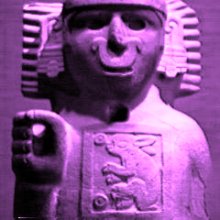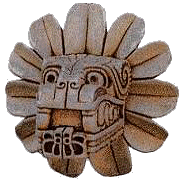
|

|
 |
|
|
|
He is one of several intoxication deities. On his chest he bears the emblem of a rabbit's face with two dots, signifying the day-sign of his birth. |
| Tlaloque. Helpers who collected water that the god stored in hills and mountains. During the rainy season, the tlaloque went to the sky carrying their jugs full of water, which they struck with their staffs, to spill the liquid on the face of the earth. Whenever a jar broke, he sound was translated into thunder. They had small bodies and always carried their staffs and jugs bearing the image of the rain god. |
|
Kukulcán was the Mayan version of the feathered serpent god Quetzalcoatl. Feathered rattlesnake images are everywhere at Chichén Itzá . For more information on the gods, please visit our glossary section, or do a site search |
|
h Puch -- The Maya god of death, also known as Hunhau, he ruled over Mitnal, the land of death, the lowest and worst of the nine hells. He was normally shown with the head of an owl on a human body. To this day, the Indians of Central America and Mexico believe that someone will die when the owl screeches. In other representations Ah Puch is shown as a skeleton or a swollen corpse, wearing bells. K’awil: the god of sustenance. K’awil is associated with royal power, which originates with the gods. The founder of the Maya culture. He brought maize and cacao and taught writing, healing, and the use of calendars. As the bringer of culture he became the state-god of the Mayan empire. As the moon-god he rules over the night. Also called 'God D' his title is 'lord of knowledge'. He is a son of Hunab Ku and with Ixchel he is the father of the Bacabs. He is related to the snake and the mussel. Most of the Mayan gods were reptilian (like a reptile) and all had dual aspects. That is-- each god had a good aspect and a evil aspect. The Mayas believed in an elaborate afterlife. Heaven was reserved for those who had been hanged, sacrificed, or died in childbirth. Everyone else went to xibal, or hell, which was ruled over by the Lords of Death. |
![]()







 Ometochtli
Ometochtli Chac -- the Rain God and Cosmic Monster Chac
is a dragon-like monster with a crocodile head and ears like a
deer. Since he exists on the edge of the sky, this cosmic monster
marks the path between the natural and supernatural worlds.
Chac -- the Rain God and Cosmic Monster Chac
is a dragon-like monster with a crocodile head and ears like a
deer. Since he exists on the edge of the sky, this cosmic monster
marks the path between the natural and supernatural worlds.